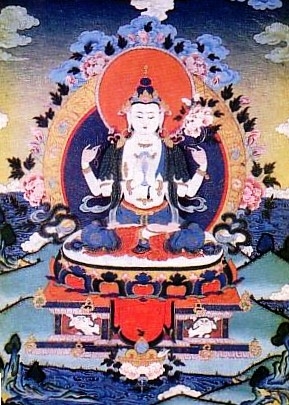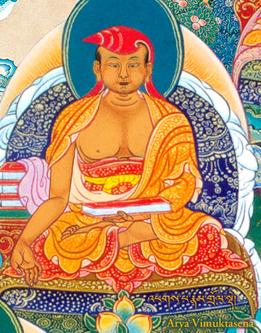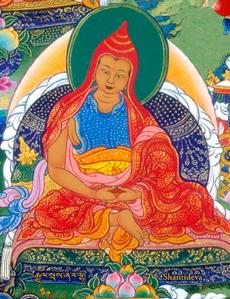Bodhichitta: Difference between revisions
No edit summary |
mNo edit summary |
||
| Line 4: | Line 4: | ||
==Nature== | ==Nature== | ||
[[Image:Arya Vimuktisena.JPG|thumb|[[Arya Vimuktisena]]]] | [[Image:Arya Vimuktisena.JPG|thumb|[[Arya Vimuktisena]]]] | ||
Buddhist scholars have debated whether bodhichitta is to be categorized as the 'main mind' (''gtso sems'') or a 'mental state' (''sems byung''). [[Asanga]] and [[Vasubandhu]] were among those claiming it is a mental state, while [[Arya Vimuktasena]] and [[Haribhadra]] believe that it is the main mind. In his ''Light on the 25,000 Verses'' (''nyi khrid snang ba''), Arya Vimuktasena specifies that it is the mental consciousness (''yid kyi rnam shes''). | Buddhist scholars have debated whether bodhichitta is to be categorized as the '[[main mind]]' (Tib. ''tso sem''; Wyl. ''gtso sems'') or a 'mental state' (Tib. ''sem jung''; Wyl. ''sems byung''). [[Asanga]] and [[Vasubandhu]] were among those claiming it is a mental state, while [[Arya Vimuktasena]] and [[Haribhadra]] believe that it is the main mind. In his ''Light on the 25,000 Verses'' (''nyi khrid snang ba''), Arya Vimuktasena specifies that it is the mental consciousness (''yid kyi rnam shes''). | ||
==Definition== | ==Definition== | ||
| Line 74: | Line 74: | ||
==Bodhichitta in Dzogchen== | ==Bodhichitta in Dzogchen== | ||
In a [[Dzogchen]] context, especially in the teachings of the [[category of mind]], bodhichitta is used to refer to the awakened mind, or | In a [[Dzogchen]] context, especially in the teachings of the [[category of mind]], bodhichitta is used to refer to the awakened mind, or [[rigpa]]. In Chapter 12 of the ''[[Treasury of the Dharmadhatu]]'', [[Longchenpa]] explains the literal meaning of bodhichitta in Dzogchen: | ||
:Within the broad expanse, the ground of naturally arising wisdom, | :Within the broad expanse, the ground of naturally arising wisdom, | ||
Revision as of 15:54, 16 October 2009

Bodhichitta (Skt. bodhicitta; Tib. chang chub kyi sem; Wyl. byang chub kyi sems) is the compassionate wish to attain enlightenment for the benefit of all beings.
Nature

Buddhist scholars have debated whether bodhichitta is to be categorized as the 'main mind' (Tib. tso sem; Wyl. gtso sems) or a 'mental state' (Tib. sem jung; Wyl. sems byung). Asanga and Vasubandhu were among those claiming it is a mental state, while Arya Vimuktasena and Haribhadra believe that it is the main mind. In his Light on the 25,000 Verses (nyi khrid snang ba), Arya Vimuktasena specifies that it is the mental consciousness (yid kyi rnam shes).
Definition
Literal Meaning/Etymology
Bodhi means our ‘enlightened essence’ and chitta (Skt. citta) means ‘heart’ or 'mind', hence the translation ‘the heart of enlightened mind’.
Scholarly Definitions
The most famous definition of bodhichitta appears in Maitreya's Abhisamayalankara:
- Arousing bodhichitta is: for the sake of others,
- Longing to attain complete enlightenment.[1]
This has twin aspects or purposes: 1) focusing on sentient beings with compassion, and 2) focusing on complete enlightenment with wisdom.
Khenpo Pema Vajra defines bodhichitta as "the wish to attain enlightenment in order to free all other sentient beings from the sufferings of existence and lead them to the unsurpassable bliss of omniscience."[2]
Khenpo Tsöndrü defines the generation of bodhichitta as "a special type of mental consciousness endowed with two aspects, inspired by the cause, longing to bring about the welfare of others, and accompanied by the support, longing to attain complete and perfect awakening."[3]
Divisions

Absolute & Relative
Bodhichitta is categorized into ‘relative’ or ‘conventional bodhichitta’, and ‘absolute bodhichitta’.
- Relative bodhichitta entails the compassionate wish to attain enlightenment for the benefit of all living beings and to train in the methods to achieve that aim.
- Absolute bodhichitta is the direct insight into the absolute nature of things.
Aspiration & Action
Within relative bodhichitta there is also the distinction between ‘bodhichitta in aspiration’ and ‘bodhichitta in action’, which is portrayed by Shantideva as the difference between deciding to go somewhere and actually making the journey:
- Understand that, briefly stated,
- Bodhicitta has two aspects:
- The mind aspiring to awaken,
- And actual application.
- Just as one understands the difference
- Between wishing to go and going on a journey,
- The wise should understand these two,
- Recognizing their difference and their order.[4]
The Three Types of Commitment
- the king's way of arousing bodhichitta, with the great wish
- the boatman's way of arousing bodhichitta, with sacred wisdom
- the shepherd's way of arousing bodhichitta, beyond compare
Four Types of Bodhichitta According to the Paths and Levels
Bodhichitta can also be divided according to the five paths and ten bhumis:
- bodhichitta of aspiring conduct (path of accumulation onwards)
- bodhichitta of pure noble intention (first bhumi onwards)
- bodhichitta of full maturation (eighth bhumi onwards)
- bodhichitta free from all obscurations (at the level of buddhahood)
There is also a division into twenty-two similes of bodhichitta, and the Sagaramatiparipriccha Sutra (Wyl. blo gros rgya mtshos zhus pa'i mdo) mentions a classification according to eighty inexhaustibles which are discussed in Mipham Rinpoche's Khenjuk.
The Actual Training in Bodhichitta
Patrul Rinpoche says that the training in bodhichitta has three elements:
- training in the cause by meditating on the four immeasurables,
- the actual training, which is to practise taking the vow of bodhichitta three times during the day and three times at night,
- and the training in the precepts, the meditations on equalizing and exchanging yourself and others, and consider others as more important than yourself.
The actual training in bodhichitta is to take the vow of bodhichitta by means of any formal practice—whether elaborate, medium or short—at the six times of the day and night, i.e., at dawn, mid-morning, midday, afternoon, dusk and midnight.
- 'Equalizing self and others’ means recognizing the equality of yourself and others in wishing to find happiness and wishing to avoid suffering.
- ‘Exchanging self and others’ means giving your own happiness to other sentient beings, and taking their suffering upon yourself.
- ‘Considering others as more important than yourself’ means setting aside your own benefit and accomplishing the benefit of others.
If you apply yourself to these practices, Patrul Rinpoche says, then you will never forget the mind of bodhichitta in all your future lives, and all the qualities of the bhumis and paths will develop and increase like the waxing moon.
Bodhichitta in Dzogchen
In a Dzogchen context, especially in the teachings of the category of mind, bodhichitta is used to refer to the awakened mind, or rigpa. In Chapter 12 of the Treasury of the Dharmadhatu, Longchenpa explains the literal meaning of bodhichitta in Dzogchen:
- Within the broad expanse, the ground of naturally arising wisdom,
- There has never been any flaw, and so, untainted by samsara, it is pure (chang).
- Enlightened qualities are present spontaneously, and therefore, beyond cause and effect, it is consummate (chub).
- In essence it is self-aware pure luminosity, and therefore it is mind (sem)—
- Within this bodhichitta, the awakened mind, utterly pure, all is contained.
This is his commentary on the verse:
- "Within the essence of rigpa, there has never been any flaw and so, since there has never been any experience of samsara, it is pure (chang). Within that very essence, enlightened qualities are spontaneously present, and so it is consummate (chub) and can arise as anything at all. It is mind (sem) because its compassionate responsiveness is all-pervasive and extends throughout all samsara and nirvana, and it is clear light; and because it arises as our own individual self-knowing rigpa."
Notes
- ↑ Abhisamayalankara I, 18, sems bskyed pa ni gzhan don phyir// yang dag rdzogs pa'i byang chub 'dod//
- ↑ gzhan sems can thams cad srid pa'i sdug bsngal las bsgral te thams cad mkhyen pa'i bde ba bla na med pa la 'jog pa'i don gyi ched du byang chub thob par 'dod pa from Notes on Bodhichitta to Illuminate the Path of the Victorious One's Heirs.
- ↑ The Words of Jikmé Chökyi Wangpo: A Commentary Presenting the Subject Matter of the Great Treatise, the Abhisamayalankara
- ↑ Bodhicharyavatara, I, 15 & 16
Further Reading
- Khunu Rinpoche, Vast as the Heavens, Deep as the Sea: Verses in Praise of Bodhicitta, Wisdom Pub., 1999.